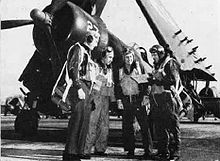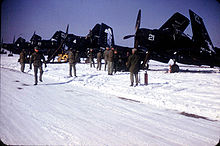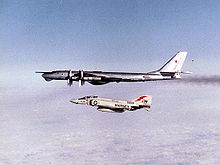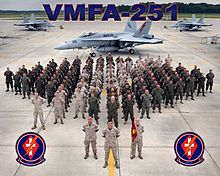- VMFA-251
-
Marine Fighter Attack Squadron 251 
VMFA-251 Insignia
courtesy of www.military-graphics.comActive - 1 December 1941 - 1 June 1945
- 1 July 1946 - present
Country United States Branch USMC Type Fighter/Attack Role Close air support
Air interdiction
Aerial reconnaissancePart of Marine Aircraft Group 31
2nd Marine Aircraft WingGarrison/HQ Marine Corps Air Station Beaufort Nickname Thunderbolts
Lucifer's Messengers (WWII)Motto "Custos Caelorum"
“Guardians of the Sky”Tail Code DW Engagements World War II
* Battle of Guadalcanal
* Philippines campaign (1944–45)
Korean War
Cold War
Operation Deny Flight
Operation Provide Promise
Operation Enduring Freedom
Operation Iraqi Freedom
* 2003 invasion of IraqCommanders Current
commanderLtCol. Michael Sobkowski[1] Aircraft flown Attack AD-4 Skyraider Fighter F4F Wildcat
F4U Corsair
FJ-3 Fury
F8U Crusader
F-4 Phantom II
F/A-18 HornetMarine Fighter Attack Squadron 251 (VMFA-251) is a United States Marine Corps F/A-18 Hornet squadron. Also known as the "Thunderbolts", the squadron is based at Marine Corps Air Station Beaufort, South Carolina and falls under the command of Marine Aircraft Group 31 (MAG-31) and the 2nd Marine Aircraft Wing (2nd MAW). The Squadron radio callsign is "T-Bolt"
Contents
History
World War II
Marine Observation Squadron 251 (VMO-251) was activated December 1, 1941 at Naval Air Station North Island, California. In mid-1942 it was transferred to Nouméa, New Caledonia and then to the island of Espiritu Santo in the British-French Condominium of New Hebrides prior to the invasion of Guadalcanal[2]. While flying the Grumman F4F Wildcat during World War II, the squadron participated in numerous Pacific campaigns including Guadalcanal, Southern Solomons, Santa Cruz, Luzon, and the Southern Philippines.
In 1944, the squadron transitioned to the F4U Corsair, and was re-designated Marine Fighter Squadron 251 (VMF-251) in February 1945. 22 F4U Corsairs from the squadron landed on Samar on 2 January 1945 as part of Marine Aircraft Group 14 (MAG-14)[3] and continued operations in the Philippines until May 1, 1945 when it flew its last combat mission of World War II while supporting clean-up operations at Leyte. The squadron's excellent performance during this time can be drawn from an award write up by the then Commanding Officer of MAG-14, Colonel Zebulon Hawkins, in which he noted, "During the month of January 1945 . . . this squadron [23 planes] flew 626 combat flights, totaling 2,403 hours. Since... 1 October 1944, until 15 February 1945, this... ground crew has maintained in commission 98% of the squadron's assigned aircraft. Not once, from June 1944, has it failed to execute an assigned mission because of failure to have the necessary planes in commission... Since 23 July 1944... this squadron has not lost a plane or pilot because of failure or malfunctioning of its aircraft[4] ."
On June 1, 1945, VMF-251 was deactivated at Samar, Philippines Island. Thirteen months later on July 1, 1946, VMF-251 was reactivated at Grosse Ile, Michigan as a ready-reserve squadron.
Korean War
With the outbreak of the Korean War in 1950, VMF-251 was recalled to active service and directed to transition to the AD4 Skyraider. In late April 1951 the squadron was transferred to Marine Corps Air Station El Toro, California. With the aircraft transition complete, the squadron was re-designated Marine Attack Squadron 251 (VMA-251) on April 25, 1951. VMA-251 embarked to Korea in June 1953. Although the squadron only saw action the last two weeks of the war, it flew 310 combat sorties totaling more than 550 hours and had the distinction of having the last Marine aircraft engaged in combat during the Korean War on 27 July 1953. VMA-251 remained in Korea for two and a half years providing air defense along the Korean Demilitarized Zone.
In January 1956, the Thunderbolts relocated to Marine Corps Air Station Iwakuni, Japan and remained in the Far East for fifteen months. In 1957, VMA-251 was again relocated to Marine Corps Air Station Miami, Florida flying the FJ-4 Fury. With the transition to the FJ-4 came the re-designation to VMF-251 on April 20, 1957.
In April 1958 VMF-251 was moved to Marine Corps Air Station El Toro, California to receive its first supersonic fighter, the F8U Crusader. The Thunderbolts departed MCAS El Toro for the Pacific carrying with them the motto “Custos Caelorum”, meaning “Guardians of the Sky”.
Cold War
In 1961, VMF-251 was assigned to Marine Aircraft Group 31 (MAG-31) at Marine Corps Air Station Beaufort, South Carolina. In August and September 1961 the squadron was deployed to Guantanamo Bay, Cuba and to Jamaica during the time between the Bay of Pigs Invasion and the Cuban Missile Crisis. From February through August 1962, VMF-251 was the first Marine F-8 squadron to deploy on board an aircraft carrier as part of Carrier Air Wing Ten (CVW-10) on the USS Shangri-La (CV-38). During the cruise, VMF-251 set the record for the most flight time in one month for a Sixth Fleet based F-8 squadron by flying over 500 hours. In July 1963 the Thunderbolts were the recipients of the 2nd MAW Commanding General's award for achievement in competitive exercises which took place while the squadron was deployed to NAS Roosevelt Roads, Puerto Rico.
On 31 October 1964, the Thunderbolts became the first Marine squadron in 2nd Marine Aircraft Wing to transition to the F-4 Phantom II and receive its current designation as Marine Fighter Attack Squadron 251 (VMFA-251)[5]. The Thunderbolts received the CNO's flight safety award in 1967 and again in 1969 as well as the Fleet Marine Force Atlantic safety award for the years 1967, 1968 and 1970. In 1969 they also received the Robert M. Hanson award, presented annually to the "most outstanding Marine fighter squadron of the year." Training exercises were conducted in Puerto Rico in 1964-1965, 1971, and 1973. In April 1971 the Squadron stood "hot pad" duty in Key West, Florida and provided additional support for the North American Defense Command. Further deployments in support of NATO were made to Cigili Air Base, Turkey in 1973 and to Rota, Spain in 1975 and the Thunderbolts participated in a Western Pacific deployment to Japan, Korea, and the Philippines during 1977-1978.
In September 1980 the Thunderbolts deployed to Trondheim in the Kingdom of Norway in support of NATO Exercises. In April 1982, the Thunderbolts again deployed to Keflavik in Iceland where the squadron intercepted six Soviet Bear Bombers while on "hot pad" alert. The squadron deployed to the Kingdom of Denmark in September 1982 for NATO Exercise "Northern Wedding 82" during which 102 Soviet aircraft flew sorties against NATO naval forces[6]. The squadron was placed on alert for possible redeployment to Lebanon before returning to the United States.
After twenty-one years and 85,000 flight hours, VMFA-251 flew its last F-4S Phantom in November 1985. In January of the following year, the Thunderbolts transitioned to the F/A-18 Hornet. The squadron stood up as the sixth Marine F/A-18A squadron the following August and reported full combat ready in March 1987.
The 1990s
From January to April 1994, the Thunderbolts flew close air support missions while deployed to Aviano, Italy supporting Operation Deny Flight in Bosnia-Herzegovina. These missions marked the first combat sorties for a Marine squadron in Europe since World War I. In 1994, the squadron became part of the Navy's Carrier Air Wing One and deployed as part of the USS America and USS George Washington battle groups from 1995 through 1997.
Global War on Terror
The squadron then deployed onboard the USS Theodore Roosevelt (CVN-71) to the Arabian Sea where it was the first Marine squadron to participate in Operation Enduring Freedom (OEF). The squadron returned to MCAS Beaufort, South Carolina in March 2002. In September 2002, the Thunderbolts were presented the Robert M. Hanson Trophy as the “Marine Fighter Attack Squadron of the Year”.
On 12 February 2003, the squadron deployed to Ahmed Al Jaber Airbase, Kuwait as part of Marine Aircraft Group 11, 3rd Marine Aircraft Wing in support of Operation Iraqi Freedom (OIF). On February 20, 2003, the squadron began flying combat missions in support of Operation Southern Watch and then transitioned to combat operations in support of OIF on 20 March 2003. During the conflict Thunderbolts flew over 650 combat missions over Iraq, accumulating more than 1,200 combat flight hours and dropped more than 7,100 weapons amounting to approximately 832,000 pounds of ordnance. Throughout the deployment maintenance Marines performed over 8,000 maintenance man-hours resulting in a 76% full mission capable rate.
In 2006 the squadron deployed to Al Asad, Iraq in support of Operation Iraqi Freedom (OIF).[7] Upon their return they again deployed, this time onboard the USS Enterprise (CVN-65). They were away from June to December 2007 and flew combat sorties in support of OIF and Operation Enduring Freedom (OEF) in Afghanistan.[8][9]
Unit Awards
 Presidential Unit Citation Streamer with one Bronze Star
Presidential Unit Citation Streamer with one Bronze Star
(19 Aug 1942 – 9 Dec 1942)
(21 Mar 2003 – 24 Apr 2004) Navy Unit Commendation Streamer with two Bronze Stars
Navy Unit Commendation Streamer with two Bronze Stars
(7 Jul 1953 – 27 Jul 1953)
(1 Oct 1997 – 30 Apr 1998)
(11 Sep 2001 – 3 Mar 2002) Meritorious Unit Commendation Streamer with four Bronze Stars
Meritorious Unit Commendation Streamer with four Bronze Stars
(1 Aug 1983 – 31 Mar 1986)
(1 Aug 1987 – 1 Jul 1989)
(25 Aug 1995 – 24 Feb 1996)
(31 Oct 1999 – 31 Mar 2000)
(1 Sep 2001 – 1 Aug 2004) Marine Corps Expeditionary Streamer
Marine Corps Expeditionary Streamer
(Cuba, Aug 1961 – Sep 1961) American Defense Service Streamer
American Defense Service Streamer
(1 Dec 1941 – 7 Dec 1941) American Campaign Streamer with one Bronze Star
American Campaign Streamer with one Bronze Star
(7 Dec 1941 – 18 Jun 1942)
(31 May 1943 – 29 Feb 1944) Asiatic/Pacific Campaign Streamer with one Silver Star and one Bronze Star
Asiatic/Pacific Campaign Streamer with one Silver Star and one Bronze Star
(Capture and Defense of Guadalcanal, 19 Aug 1942 - 8 Feb 1943)
(Consolidation of the Southern Solomons, 9 Feb 1943 - 11 May 1943)
(Santa Crux, 26 Oct 1943)
(Consolidation of the Northern Solomons, 18 Jun 1944 - 30 Dec 1944)
(Luzon Operation, 3 Jan 1945 - 1 April 1945)
(Southern Philippines, 2 April 1945 - 1 May 1945) World War II Victory Streamer
World War II Victory Streamer
(7 Dec 1941 – 1 Jun 1945) National Defense Service Streamer with three Bronze Stars
National Defense Service Streamer with three Bronze Stars
(27 Jun 1950 – 27 Jul 1954)
(1 Jan 1961 – 14 Aug 1974)
(2 Aug 1990 – 30 Nov 1995)
(11 Sep 2001 – TBD) Korean Service Streamer with one Bronze Star
Korean Service Streamer with one Bronze Star
(5 Jul 1953 – 27 Jul 1953) Armed Forces Expeditionary Medal Streamer
Armed Forces Expeditionary Medal Streamer
(Operation Southern Watch, 20 Feb 2003 – 18 Mar 2003) Southwest Asia Service Medal Streamer
Southwest Asia Service Medal Streamer
(Operation Southern Watch, Nov 1995 - Nov 1995) Afghanistan Campaign Medal Streamer
Afghanistan Campaign Medal Streamer
(Operation Enduring Freedom, Jul 2007 - Dec 2007) Iraq Campaign Medal Streamer
Iraq Campaign Medal Streamer
(Operation Iraqi Freedom, 2006 - 2006) Global War on Terrorism Expeditionary Medal Streamer
Global War on Terrorism Expeditionary Medal Streamer
(Operation Enduring Freedom, 11 Sep 2001 – Mar 2002) Global War on Terrorism Service Medal Streamer
Global War on Terrorism Service Medal Streamer
(Operation Enduring Freedom, 11 Sep 2001 – Mar 2002)
(Operation Iraqi Freedom, 20 Mar 2003 – 2003) Philippine Presidential Unit Citation Streamer
Philippine Presidential Unit Citation Streamer
(2 Jan 1945 – 1 Jun 1945) Korean Presidential Unit Citation Streamer
Korean Presidential Unit Citation Streamer
(27 Feb 1951 – 11 Jun 1953) Philippine Liberation Streamer with one Bronze Star
Philippine Liberation Streamer with one Bronze Star
(2 Jan 1945 – 2 Jun 1945)
(2 Jan 1945 – 1 May 1945)
See also
References
- Notes
 This article incorporates public domain material from websites or documents of the United States Marine Corps.
This article incorporates public domain material from websites or documents of the United States Marine Corps.
- ^ New Marine squadron commander in Beaufort
- ^ "Marine Observation Squadron (VMO-251) History". MCARA Units. http://www.mcara.us/VMO-251.html. Retrieved 2010-11-25.
- ^ Tillman (1979), p.90.
- ^ Maj Boggs, Charles W.. "Marine Aviation in the Philippines". http://www.ibiblio.org/hyperwar/USMC/USMC-M-AvPhil/USMC-M-AvPhil-2.html. Retrieved 2007-12-17.
- ^ Flemming, Nikki (October 12, 2006). "Thunderbolts add to their rich history". Marine Corps News. U.S. Marine Corps. http://www.marines.mil/units/marforpac/imef/3rdmaw/Pages/2006/Thunderbolts%20add%20to%20their%20rich%20history.aspx. Retrieved 2008-04-12.[dead link]
- ^ Arkin, William M. (September, 1987). "Navy autonomy thwarts arms control". Bulletin of the Atomic Scientists, Vol. 43, No. 7. http://books.google.com/books?id=mgYAAAAAMBAJ&lpg=PP1&pg=PP1#v=onepage&q&f=false. Retrieved 2010-11-25.
- ^ "Commandant, Marine Corps sergeant major visit Thunderbolts at Al Asad". Marine Corps News. U.S. Marine Corps. http://www.marines.mil/marinelink/mcn2000.nsf/main5/197023C51EC78ABF8525720A00618723?opendocument.
- ^ "VMFA-251, VFA-86 to return to Beaufort Sunday". 14 December 2007. http://www.marinecorpstimes.com/news/2007/12/marine_vmfa251_returns_071212/. Retrieved 2007-12-14.
- ^ Cpl Mecure, James M. (21 December 2007). "Thunderbolts, Sidewinders return from 6-month deployment". Archived from the original on 2008-03-04. http://web.archive.org/web/20080304094614/http://www.marines.mil/marinelink/mcn2000.nsf/0/EEAC4B79DE130096852573B8004DAD22?opendocument. Retrieved 2007-12-21.
- Bibliography
- Crowder, Michael J. (2000). United States Marine Corps Aviation Squadron Lineage, Insignia & History - Volume One - The Fighter Squadrons. Turner Publishing Company. ISBN 1-56311-926-9.
- Rottman, Gordon L. (2002). U.S. Marine Corps World War II Order of Battle - Ground and Air Units in the Pacific War, 1939 - 1945.’’. Greenwood Press. ISBN 0-313-31906-5.
- Sherrod, Robert (1952). History of Marine Corps Aviation in World War II. Washington, D.C.: Combat Forces Press.
- Tillman, Barrett. Corsair - The F4U in World War II and Korea. Annapolis, Maryland: Naval Institute Press, 1979. ISBN 1-55750-944-8.
- Web
MAG-14 
MAG-26 MAG-29 MAG-31 MACG-28 MWSG-27 Categories:- United States Marine Corps fixed wing squadrons
Wikimedia Foundation. 2010.








